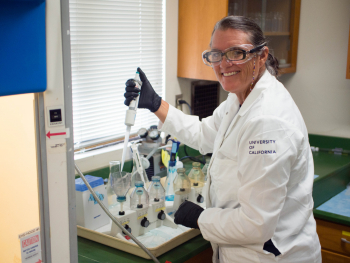
School:
Grade Level:
Teaching Position:
Supervisor:
Department:
Mentor:
Research Project Year:
Research Project Title:
Research Project Description:
Transparent exopolymer particles (TEP) are the critical “glue” that holds together biological debris, as they aggregate and sink through the water column. TEP are abundant in the ocean and algae cultures and play an important role in many oceanographic processes. Transparent exopolymer particles are formed abiotically from dissolved precursors. Currently scientists can stain and measure TEP but there is no method to stain and measure TEP-precursors. TEP-precursors are rich in acidic polysaccharides and are released by marine phytoplankton (algae), bacteria and many other organisms. Scientists think that these precursors are more abundant than TEP. The goal of my project was to test a possible procedure to measure the precursors of transparent exopolymer particles (TEP). During my six-week experience, I calibrated an AB (Alcian Blue) stain solution which is an established method used to measure TEP and developed an “artificial TEP-precursor” solution using Gum Xanthan to use in the trials. In the trials, materials such as different types of glass wool were tested to try to extract the precursors. Because TEP and TEP precursors are so sticky, we expect them to adhere quantitatively to the glass wool, removing them from the water. Separation of TEP-precursors from the seawater is important because the AB stain can’t be added to seawater, as it reacts with salt creating artifacts. Ultimately if a method can be successfully developed to measure the precursors of TEP, scientists can further understand their role in the oceanographic processes and the biological pump as well as how these precursors are affected by human interaction such as ocean acidification and oil spills.
Curriculum Project Year:
Curriculum Project Title:
Curriculum Project Description:
This portfolio contains activities that focus on ocean ecosystems and how these systems are affected by four human induced problems: microplastics, oil spills, ocean temperature increase and ocean acidification. These activities are designed to allow students to build on their knowledge of the ocean and ultimately evaluate that knowledge in an experiment designed by the student. This experiment will demonstrate an understanding of one of these problems and how it affects the biological or physical components of the ocean in a given population of marine organisms. After participation in this unit, students will have a deeper understanding of their impact on our environment and begin to think about solutions to environmental issues that plague the ocean today and in the future.
Curriculum Project Attachments:
| Attachment | Size |
|---|---|
| 23.04 MB |
